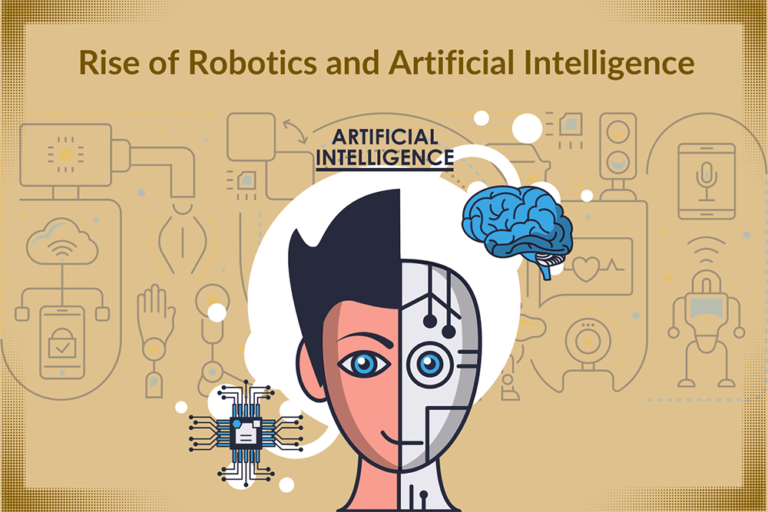
AI in Robotics: The Rise of Intelligent Automation – A Beginner’s Guide
Imagine a world where machines don’t just follow pre-programmed commands but can learn, adapt, and even make decisions on their own. This isn’t science fiction anymore; it’s the rapidly unfolding reality of AI in Robotics, leading to what we call Intelligent Automation.
From manufacturing floors to hospital operating rooms, and even in our homes, robots are becoming smarter, more capable, and increasingly integrated into our daily lives. This article will break down what AI in robotics means, how it works, and why it’s revolutionizing industries worldwide, all in a way that’s easy for anyone to understand.
What Exactly is AI in Robotics?
To grasp AI in robotics, let’s first look at the two components separately:
-
Robotics: At its core, robotics is about designing, building, operating, and applying robots. Traditionally, robots were programmed to perform specific, repetitive tasks with high precision. Think of a car assembly line where a robot arm welds the same spot on every car. They excel at speed and accuracy but lack flexibility.
-
Artificial Intelligence (AI): AI is the science of making machines think and learn like humans. It’s about giving computers the ability to:
- Understand: Process information (like images, sounds, or text).
- Reason: Solve problems and make decisions.
- Learn: Improve performance over time with experience, without being explicitly programmed for every scenario.
So, AI in Robotics is simply the fusion of these two powerful fields. It means equipping robots with AI capabilities, allowing them to perceive their environment, process complex data, learn from experience, and make autonomous decisions. This transforms rigid, repetitive machines into flexible, adaptive, and truly "intelligent" systems.
Key Technologies Powering Intelligent Automation
How do robots become "intelligent"? It’s thanks to several branches of AI working together:
-
1. Machine Learning (ML):
- What it is: ML is the foundation of modern AI. It’s about giving computers the ability to "learn" from data without being explicitly programmed. Instead of writing rules for every possible situation, you feed the machine vast amounts of data, and it finds patterns and makes predictions.
- How it helps robots:
- Object Recognition: A robot can learn to identify different types of products on a conveyor belt.
- Predictive Maintenance: Robots can analyze data from their own sensors to predict when a part might fail, allowing for maintenance before a breakdown.
- Task Optimization: Learning the most efficient way to complete a task after many attempts.
-
2. Deep Learning (DL):
- What it is: A specialized form of Machine Learning that uses "neural networks" inspired by the human brain. These networks have multiple layers, allowing them to learn incredibly complex patterns and relationships from huge datasets.
- How it helps robots:
- Advanced Vision: Recognizing subtle defects in products, even tiny scratches or color variations.
- Complex Manipulation: Learning precise movements needed for delicate tasks, like handling fragile objects or performing surgical procedures.
- Natural Language Understanding: Allowing robots to understand spoken commands or instructions more accurately.
-
3. Computer Vision:
- What it is: This AI field enables computers to "see" and interpret visual information from the world, just like humans do. It uses cameras and sophisticated algorithms to process images and videos.
- How it helps robots:
- Navigation: Autonomous robots (like delivery robots or self-driving cars) use computer vision to map their environment, detect obstacles, and navigate safely.
- Quality Control: Inspecting products for flaws or correct assembly.
- Picking & Placing: Identifying objects in a bin and precisely grasping them.
-
4. Natural Language Processing (NLP):
- What it is: NLP gives computers the ability to understand, interpret, and generate human language.
- How it helps robots:
- Voice Commands: Interacting with robots using natural spoken language.
- Customer Service: Robots (or chatbots integrated with robotic systems) can understand and respond to customer queries.
- Instruction Following: Understanding complex verbal instructions for tasks.
-
5. Reinforcement Learning (RL):
- What it is: A type of ML where an AI agent learns to make decisions by performing actions in an environment and receiving "rewards" or "penalties" based on its success or failure. It’s like training a pet: good behavior gets a treat, bad behavior gets a reprimand.
- How it helps robots:
- Learning New Skills: A robot can learn to pick up unfamiliar objects by trial and error, improving its grip and technique over time.
- Optimizing Movement: Finding the most efficient and energy-saving way to move its limbs or navigate.
- Adapting to Change: Quickly adjusting its behavior when the environment changes (e.g., a new obstacle appears).
How AI is Transforming Robotics: Real-World Applications
The integration of AI is pushing robots beyond their traditional roles, creating "intelligent automation" across various sectors:
1. Manufacturing and Industry
- Smart Factories: Robots don’t just perform repetitive tasks; they monitor the entire production line, predict equipment failures, and optimize workflows.
- Quality Control: AI-powered vision systems can detect microscopic defects that human eyes might miss, ensuring higher product quality.
- Adaptive Production: Robots can quickly switch between different products or tasks without extensive re-programming, making production lines more flexible.
2. Logistics and Warehousing
- Autonomous Mobile Robots (AMRs): Unlike traditional Automated Guided Vehicles (AGVs) that follow fixed paths, AMRs use AI to navigate dynamic warehouse environments, avoiding obstacles and finding the most efficient routes to pick and transport goods.
- Automated Picking: Robots with AI vision and grasping capabilities can identify, pick, and sort individual items from shelves or bins, greatly speeding up order fulfillment.
3. Healthcare
- Surgical Assistance: AI helps robotic surgical systems perform with incredible precision, analyzing patient data in real-time to assist surgeons and reduce human error.
- Patient Care: Robots can assist with mundane tasks like delivering medications, sanitizing rooms, or even monitoring vital signs, freeing up human staff for more critical patient interaction.
- Drug Discovery: AI-powered robots can automate lab experiments, analyzing vast amounts of data to accelerate the discovery of new drugs and treatments.
4. Agriculture
- Precision Farming: AI robots can autonomously monitor crop health, identify weeds, and precisely apply fertilizers or pesticides, reducing waste and improving yields.
- Automated Harvesting: Robots are being developed to identify ripe fruits and vegetables and harvest them gently, overcoming labor shortages and reducing damage.
5. Service and Exploration
- Cleaning and Hospitality: Intelligent robots clean large public spaces, deliver room service, or provide concierge services in hotels.
- Exploration: AI-powered robots are essential for exploring dangerous or inaccessible environments, from deep-sea trenches to other planets (e.g., NASA’s Mars rovers).
- Customer Service: From humanoid robots greeting visitors to advanced kiosks, AI allows robots to understand queries and provide assistance.
The Rise of Collaborative Robots (Cobots)
One of the most exciting developments driven by AI is the rise of collaborative robots, or cobots. Unlike traditional industrial robots that are caged off for safety, cobots are designed to work alongside humans.
- Safety First: Equipped with advanced sensors and AI, cobots can detect human presence and automatically slow down or stop to prevent collisions.
- Flexible Assistance: They can assist workers with heavy lifting, repetitive tasks, or precision work, acting as a helpful "third hand."
- Easy to Program: Many cobots can be "taught" new tasks by simply guiding their arm through the desired motions, making them highly adaptable even for small businesses.
This human-robot collaboration is changing the workplace, making processes more efficient and safer, and allowing humans to focus on more complex, creative, and value-added tasks.
Challenges and Considerations
While the future of AI in robotics is bright, there are important challenges to address:
-
Ethical Concerns:
- Accountability: Who is responsible if an autonomous robot makes a mistake that causes harm?
- Bias: If AI is trained on biased data, it can perpetuate and amplify those biases in its decisions.
- Privacy: Robots collecting vast amounts of data raise concerns about how that data is stored and used.
-
Job Market Impact:
- Job Displacement: There’s a valid concern that intelligent automation will replace certain jobs, especially those that are repetitive or routine.
- Job Creation: However, AI and robotics also create new jobs in areas like robot maintenance, AI development, data analysis, and human-robot interaction design. The focus will shift from manual labor to oversight, programming, and strategic thinking.
-
Technical Complexity and Cost:
- Developing and implementing advanced AI robotic systems can be complex and expensive, especially for smaller businesses.
- Ensuring seamless integration with existing systems and maintaining these advanced technologies requires specialized skills.
The Future of Intelligent Automation
The journey of AI in robotics is just beginning. We can expect to see:
- Greater Autonomy: Robots will become even more self-sufficient, capable of handling complex and unpredictable situations with minimal human intervention.
- More Human-like Interaction: Advances in NLP and computer vision will make interactions with robots feel more natural and intuitive.
- Miniaturization: Smaller, more agile robots for specialized tasks, from micro-surgery to environmental monitoring.
- Wider Adoption: As costs decrease and capabilities increase, intelligent automation will become commonplace across even more industries and in our homes.
- Swarm Robotics: Groups of simpler robots working together as a collective intelligence to accomplish complex tasks, much like ant colonies.
Conclusion
AI in robotics is not just an incremental improvement; it’s a fundamental shift in how we approach automation. By imbuing machines with the ability to learn, adapt, and make intelligent decisions, we are unlocking unprecedented levels of efficiency, safety, and innovation.
While challenges like ethical considerations and workforce adaptation need careful management, the rise of intelligent automation promises a future where humans and smart machines collaborate to solve some of the world’s most complex problems, leading us towards a more productive, precise, and potentially prosperous tomorrow. The age of intelligent automation is truly upon us, and it’s set to reshape our world in exciting and profound ways.



Post Comment